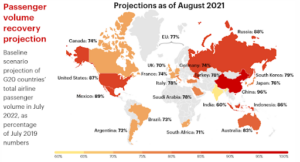Author: Jonathan Sloan, EVP, Europe and Middle East Strategy
Finally, after 20 months of false starts and postponed travel plans, the U.S. has put up their “Open for Business” sign for fully vaccinated British travellers beginning in November. While long overdue and a heavy weight lifted off the UK travel sector that relies on the lucrative transatlantic leisure traffic, expect different booking patterns and consumer behaviour – particularly over the next few months.
Pent-Up demand
We all know there has been huge pent-up demand for travel to the U.S. over the last 20 months. The UK, prior to the pandemic, was the largest overseas tourism market to the U.S., and according to WTTC, the UK alone represents 8% of all inbound travel, accounting for $40 million per day to the nation’s economy.
The UK has been consistently sending around 4 million visitors a year to the U.S. over the last decade, peaking at 4.9 million in 2015. While air travel is not expected to return to pre-pandemic levels until 2023 at the earliest, UK flight levels are predicted to be back to 70% by summer next year (see table below). Based on this data, predictions put the potential of travel by UK visitors to the U.S. for 2022 at around 3 million, hopefully defending the title of largest overseas market.

Changing Booking Windows
In the past, the Brits have been a fairly predictable bunch when it comes to booking travel to the U.S. with four to six month lead times, mainly booking in the peak booking periods of January through March with an average trip duration of around 12-day trips.
The opening of the late summer intra-European travel meant many British travellers threw the traditional booking window manual out of the window, often taking last-minute European trips based on changes in travel restrictions and the government’s traffic light system. Travelport’s UK to U.S. booking window before the recent announcement was sitting at around 110 days. Expect this to shorten dramatically, particularly when the actual November travel opening date is announced, with pent-up demand pushing bookings into the last two months of 2021 and into Q1 2022. In 2019, November saw 345,000 UK travellers visit the U.S. – and in December, 376,000 – so expect New York shopping trips, ski resorts visits, winter sun seeking, and the pent-up desire to visit friends and family to push the last-minute booking market for the remainder of 2021 and into early 2022.
Staying longer
Expect to have the British traveller for longer. Travelport’s GDS data before the announcement was already showing British travellers booking U.S. trips were lengthening their stay from 13 to 15 days. British households saved £192 billion in 2020 according to the Bank of England, and £50 billion is earmarked for expenditure over the next 12 months. It is no surprise with the findings released by the Centre for Economics and Business Research that the number one priority on where the Brits will be spending these lockdown savings are on overseas travel, with 34% of those polled putting it as their top priority. While the total arrival numbers to the U.S. from the UK will be down for 2022, watch out for the longer-staying and big-spending British visitor.
The special UK/U.S. traveller relationship coupled with the green light to travel offers a once-in-a-lifetime opportunity for U.S.-based marketers to capture the return of the number one overseas market. To capture this short-lead business, there is a need for quick, adventurous and nimble in-market activity utilising direct consumer digital channels, coupled with investing in reliable and up-to-date research in an ever-changing travel landscape. The pandemic has seen a significant resurgence and reliance on the travel trade by the British public, so upcoming in-market events through the Visit USA Association, along with Brand USA Travel Week and WTM, will provide imminent face-to-face opportunities to reengage with UK travel partners.
The coming weeks will certainly deliver a few curve balls, and travel marketers on both sides of the pond need to be ready to reap the benefits.